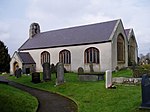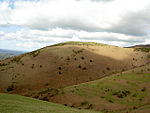Ty Coch Cruck Barn, Llangynhafal, Denbighshire
Grade II listed barns in WalesGrade II listed buildings in DenbighshireHouses in DenbighshireLlangynhafalTimber-framed buildings in Wales

The Cruck barn on the Ty Coch estate at Llangynhafal, Denbighshire, is a timber framed building, which has been dated by dendrochronology to 1430. It is one of the earliest timber-framed buildings in Wales. Although there is evidence that the building was a house originally, it was converted to agricultural use and is often described as a barn. The significance of the barn was recognised by Cadw in 2002 when it was listed as a Grade II listed building. Previously the building had been thought to be 17th century. It has recently been restored by the Denbighshire County Council, with European and other grant funding, as part of a small workshop complex.
Excerpt from the Wikipedia article Ty Coch Cruck Barn, Llangynhafal, Denbighshire (License: CC BY-SA 3.0, Authors, Images).Ty Coch Cruck Barn, Llangynhafal, Denbighshire
Hwlfa Llwyn,
Geographical coordinates (GPS) Address Nearby Places Show on map
Geographical coordinates (GPS)
| Latitude | Longitude |
|---|---|
| N 53.164192 ° | E -3.303767 ° |
Address
Hwlfa Llwyn
LL16 4LN
Wales, United Kingdom
Open on Google Maps








